
Gibson William Hamilton
My Studio Neighbors
As in previous instances, observing that the interloper had a voice fully capable of making his wants known, I gave the comfortable little beast ample room to spread himself on the ground, and let the lone little starveling survivor of the rightful brood have his cot all to himself.
And yet, as I left the spot, I confess to a certain misgiving, as the pleading chirrup of the ousted fledgling followed me faintly and more faintly up the hill, recalling, too, the many previous similar acts of mine—and one in particular, when I had slaughtered in cold blood two of these irresponsibles found in a single nest. But sober second thought evoked a more philosophic and conscientious mood, the outcome of which leading, as always, to a semi-conviction that the complex question of reconciliation of duty and humanity in the premises was not thus easily disposed of, considering, as I was bound to do, the equal innocence of the chicks, both of which had been placed in the nest in obedience to a natural law, which in the case of the cow-bird was none the less a divine institution because I failed to understand it. Such is the inevitable, somewhat penitent conclusion which I always arrive at on the cow-bird question; and yet my next cow-bird fledgling will doubtless follow the fate of all its predecessors, the reminiscent qualms of conscience finding a ready philosophy equal to the emergency; for if, indeed, this parasite of the bird home be a factor in the divine plan of Nature's equilibrium, looking towards the survival of the fittest and the regulation of the sparrow and small-bird population, which we must admit, how am I to know but that this righteous impulse of the human animal is not equally a divine, as it is certainly a natural institution looking to the limitations of the cow-bird? One June morning, a year or two ago, I heard a loud squeaking, as of a young bird in the grass near my door, and, on approaching, discovered the spectacle of a cow-bird, almost full-fledged, being fed by its foster-mother, a chippy not more than half its size, and which was obliged to stand on tiptoe to cram the gullet of the parasite.
The victims of the cow-bird are usually, as in this instance, birds of much smaller size, the fly-catchers, the sparrows, warblers, and vireos, though she occasionally imposes on larger species, such as the orioles and the thrushes. The following are among its most frequent dupes, given somewhat in the order of the bird's apparent choice: song-sparrow, field-sparrow, yellow warbler, chipping-sparrow, other sparrows, Maryland yellow-throat, yellow-breasted chat, vireos, worm-eating warbler, indigo-bird, least-flycatcher, bluebird, Acadian flycatcher, Canada flycatcher, oven-bird, king-bird, cat-bird, phœbe, Wilson's thrush, chewink, and wood-thrush.
But one egg is usually deposited in a single nest; the presence of two eggs probably indicates, as in the case of the European cuckoo, the visits of two cow-birds rather than a second visit from the same individual—the presence of two cow-bird chicks of equal size being rather a proof of this than otherwise, in that kind Nature would seem to have accommodated the bird with an exceptional physiological resource, which matures its eggs at intervals of three or more days, as against the daily oviposition of its dupes, thus giving it plenty of time to make its search and take its pick among the bird-homes. Whether the process of evolution has similarly equipped our cow-bird I am not aware; but the vicious habits of the two birds are so identical that the same accommodating functional conditions might reasonably be expected. It is, indeed, an interesting fact well known to ornithologists that our own American cuckoos, both the yellow-billed and black-billed, although rudimentary nest-builders, still retain the same exceptional interval in their egg-laying as do their foreign namesake. The eggs are laid from four days to a week apart, instead of daily, as with most birds, their period of perilous nidification on that haphazard apology of a nest being thus possibly prolonged to six weeks. Thus we find, in consequence, the anomalous spectacle of the egg and full-grown chick, and perhaps one or two fledglings of intermediate stages of growth, scattered about at once, helter-skelter, in the same nest. Only two years ago I discovered such a nest not a hundred feet from my house, containing one chick about two days old, another almost full-fledged, while a fresh-broken egg lay upon the ground beneath. Such a household condition would seem rather demoralizing to the cares of incubation, and doubtless the addled or ousted egg is a frequent episode in our cuckoo's experience.
It is an interesting question which the contrast of the American and European cuckoo thus presents. Is the American species a degenerate or a progressive nest-builder? Has she advanced in process of evolution from a parasitical progenitor building no nest, or is the bird gradually retrograding to the evil ways of her notorious namesake?
The evidence of this generic physiological peculiarity in the intervals of oviposition, taken in consideration with the fact of the rudimentary nest, would seem to indicate the retention of a now useless physiological function, and that the bird is thus a reformer who has repudiated the example of her ancestors, and has henceforth determined to look after her own babes.
With the original presumed object of this remarkable prolonged interval in egg-laying now removed, the period will doubtless be reduced through gradual evolution to accommodate itself to the newly adopted conditions. The week's interval, taken in connection with the makeshift nest or platform of sticks, is now a disastrous element in the life of the bird. Such of the cuckoos, therefore, as build the more perfect nests, or lay at shortest intervals, will have a distinct advantage over their less provident fellows, and the law of heredity will thus insure the continual survival of the fittest.
The cuckoo is not alone among British birds in its intrusion on other nests. Many other species are occasionally addicted to the same practice, though such acts are apparently accidental rather than deliberate, so far as parasitical intent is concerned. The lapse is especially noticeable among such birds as build in hollow trees and boxes, as the woodpeckers and wagtails. Thus the English starling will occasionally impose upon and dispossess the green woodpecker. In the process of nature in such cases the stronger of the two birds would retain the nest, and thus assume the duties of foster-parent. Starting from this reasonable premise concerning the prehistoric cuckoo, it is not difficult to see how natural selection, working through ages of evolution by heredity, might have developed the habitual resignation of the evicted bird, perhaps to the ultimate entire abandonment of the function of incubation. Inasmuch as "we have no experience in the creation of worlds," we can only presume.
Indeed, the similarities and contrasts afforded by a comparison of the habits of all these birds—European cuckoo, American cuckoo, and cow-bird—afford an interesting theme for the student of evolution. What is to be the ultimate outcome of it all? for the murderous cuckoo must be considered merely as an innocent factor in the great scheme of Nature's equilibrium, in which the devourer and the parasite would seem to play the all-important parts, the present example being especially emphasized because of its conspicuousness and its violence to purely human sentiment. The parasite would often seem to hold the balance of power.
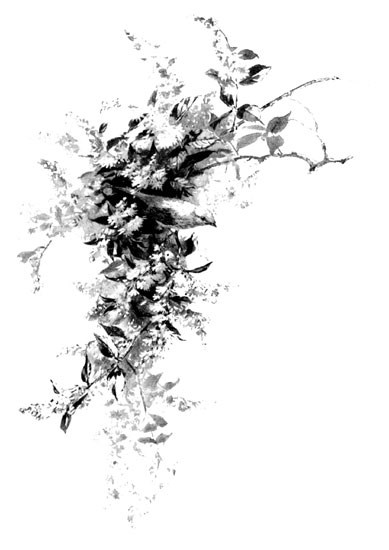
The Yellow Warbler
Jonathan Swift's epitome of the subject, if not specifically true, is at least correct in its general application:
"A flea
Has smaller fleas that on him prey;
And these have smaller still to bite 'em;
And so proceed ad infinitum."
Even the tiny egg of a butterfly has its ichneumon parasite, a microscopic wasp, which lays its own egg within the larger one, which ultimately hatches a wasp instead of the baby caterpillar.
But who ever heard of anything but good luck falling to the lot of cow-bird or cuckoo, except as its blighting course is occasionally arrested by the outraged human? They always find a feathered nest.
In this connection it is interesting to note certain developments in bird life upon the lines of which evolution might work with revolutionary effect. Most of our birds are helpless and generally resigned victims to the cow-bird, but there are indications of occasional effective protest among them. Thus the little Maryland yellow-throat, according to various authorities, often ousts the intruded egg, and its broken remains are also occasionally seen on the ground beneath the nests of the cat-bird and the oriole. The red-eyed vireo, on the other hand, though having apparently an easier task than the latter, in the lesser depth of her pensile nest, commonly abandons it altogether to the unwelcome speckled ovum—always, I believe, if the cow-bird has anticipated her own first egg.
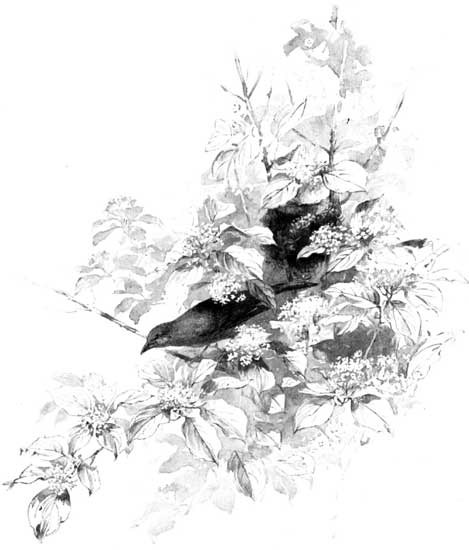
A Blighted Home
But we have a more remarkable example of opposition in the resource of the little yellow warbler, which I have noted as one of the favorite dupes of the cow-bird—a deliberate, intelligent, courageous defiance and frequent victory which are unique in bird history, and which, if through evolutionary process they became the fashion in featherdom, would put the cow-bird's mischief greatly at a discount. The identity of this pretty little warbler is certainly familiar to most observant country dwellers, even if unknown by name, though its golden-yellow plumage faintly streaked with dusky brown upon the breast would naturally suggest its popular title of "summer yellow-bird." It is one of the commonest of the mnio-tiltidæ, or wood-warblers, though more properly a bird of the copse and shrubbery than of the woods.

The Normal Nest of the Yellow Warbler
This nest is a beautiful piece of bird architecture. In a walk in search of one only a day or two ago I procured one, which is now before me. It was built in the fork of an elder-bush, to which it was moored by strips of fine bark and cobweb, its downy bulk being composed by a fitted mass of fine grass, willow cotton, fern wood, and other similar ingredients. It is about three inches in depth, outside measurement. But this depth greatly varies in different specimens. Our next specimen may afford quite a contrast, for the yellow warbler occasionally finds it to her interest to extend the elevation of her dwelling to a remarkable height. On page 50 is shown one of these nests, snugly moored in the fork of a scrub apple-tree. Its depth from the rim to the base, viewed from the outside, is about five inches, at least two inches longer than necessity would seem to require, and apparently with a great waste of material in the lower portion, as the hollow with the pretty spotted eggs is of only the ordinary depth of about two inches, thus hardly reaching half-way to the base. Let us examine it closely. There certainly is a suspicious line or division across its upper portion, about an inch below the rim, and extending more or less distinctly completely around the nest. By a very little persuasion with our finger-tip the division readily yields, and we discover the summit of the nest to be a mere rim—a top story, as it were—with a full-sized nest beneath it as a foundation. Has our warbler, then, come back to his last year's home and fitted it up anew for this summer's brood? Such would be a natural supposition, did we not see that the foundation is as fresh in material as the summit. Perhaps, then, the bird has already raised her first spring brood, and has simply extended her May domicile, and provided a new nursery for a second family. But either supposition is quickly dispelled as we further examine the nest; for in separating the upper compartment we have just caught a glimpse of what was, perhaps only yesterday, the hollow of a perfect nest; and, what is more to the point of my story, the hollow contains an egg—perhaps two, in which case they will be very dissimilar, one of delicate white with faint spots of brown on its larger end, the putting of the warbler, the other much larger, with its greenish surface entirely speckled with brown, and which, if we have had any experience in bird-nesting, we immediately recognize as the mischievous token of the cow-bird. We have discovered a most interesting curiosity for our natural-history cabinet—the embodiment of a presumably new form of intelligence in the divine plan looking to the survival of the fittest. It is not known how many years or centuries it has taken the little warbler to develop this clever resource to outwit the cow-bird. It is certain, however, that the little mother has got tired of being thus imposed upon, and is the first of her kind on record which has taken these peculiar measures for rising above her besetting trouble.
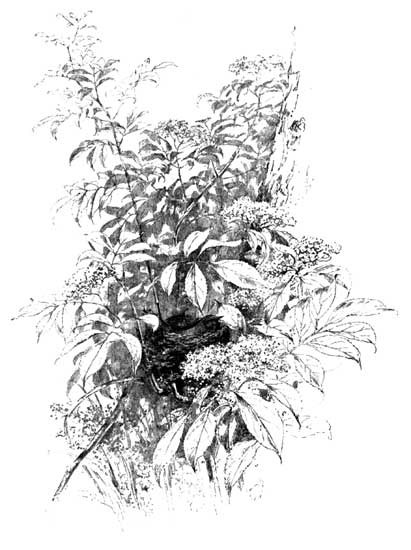
The Yellow Warbler at Home
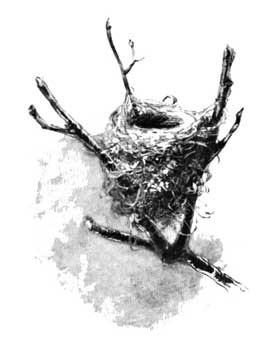
A Suspicious Nest of the Yellow Warbler
Who can tell what the future may develop in the nests of other birds whose homes are similarly invaded? I doubt not that this crying cow-bird and cuckoo evil comes up as a matter of consideration in bird councils. The two-storied nest may yet become the fashion in featherdom, in which case the cow-bird and European cuckoo would be forced to build nests of their own or perish.
But have we fully examined this nest of our yellow warbler? Even now the lower section seems more bulky than the normal nest should be. Can we not trace still another faint outline of a transverse division in the fabric, about an inch below the one already separated? Yes; it parts easily with a little disentangling of the fibres, and another spotted egg is seen within. A three-storied nest! A nest full of stories—certainly. I recently read of a specimen containing four stories, upon the top of which downy pile the little warbler sat like Patience on a monument, presumably smiling at the discomfiture of the outwitted cow-bird parasite, who had thus exhausted her powers of mischief for the season, and doubtless convinced herself of the folly of "putting all her eggs in one basket."

The Nest Separated
When we consider the life of the cow-bird, how suggestive is this spectacle which we may see every year in September in the chuckling flocks massing for their migration, occasionally fairly blackening the trees as with a mildew, each one the visible witness of a double or quadruple cold-blooded murder, each the grim substitute for a whole annihilated singing family of song-sparrow, warbler, or thrush! What a blessing, at least humanly speaking, could the epicurean population en route in the annual Southern passage of this dark throng only learn what a surpassing substitute they would prove—on toast—for the bobolinks which as "reed-birds" are sacrificed by the thousands to the delectable satisfaction of those "fine-mouthed and daintie wantons who set such store by their tooth"!
And what the cow-bird is, so is the Continental "cuckoo." Shall we not discriminate in our employment of the superlative? What of the throstle and the lark? Shall we still sing—all together:
"O cuckoo! I hear thee and rejoice!
Thrice welcome darling of the spring."
DOOR-STEP NEIGHBOURS
HOW little do we appreciate our opportunities for natural observation! Even under the most apparently discouraging and commonplace environment, what a neglected harvest! A back-yard city grass-plot, forsooth, what an invitation! Yet there is one interrogation to which the local naturalist is continually called to respond. If perchance he dwells in Connecticut, how repeatedly is he asked, "Don't you find your particular locality in Connecticut a specially rich field for natural observation?" The botanist of New Jersey or the ornithologist of Esopus-on-Hudson is expected to give an affirmative reply to similar questions concerning his chosen hunting-grounds, if, indeed, he does not avail himself of that happy aphorism with which Gilbert White was wont to instruct his questioners concerning the natural-history harvest of his beloved Selborne: "That locality is always richest which is most observed."
The arena of the events which I am about to describe and picture comprised a spot of almost bare earth less than one yard square, which lay at the base of the stone step to my studio door in the country.
The path leading to the studio lay through a tangle of tall grass and weeds, with occasional worn patches showing the bare earth. As it approached the door-step the surface of the ground was quite clean and baked in the sun, and barely supported a few scattered, struggling survivors of the sheep's-sorrel, silvery cinquefoil, ragweed, various grasses, and tiny rushes which rimmed the border. Sitting upon this threshold stone one morning in early summer, I permitted my eyes to scan the tiny patch of bare ground at my feet, and what I observed during a very few moments suggested the present article as a good piece of missionary work in the cause of nature, and a suggestive tribute to the glory of the commonplace. The episodes which I shall describe represent the chronicle of a single day—in truth, of but a few hours in that day—though the same events were seen in frequent repetition at intervals for months. Perhaps the most conspicuous objects—if, indeed, a hole can be considered an "object"—were those two ever-present features of every trodden path and bare spot of earth anywhere, ant-tunnels and that other circular burrow, about the size of a quill, usually associated, and which is also commonly attributed to the ants.
As I sat upon my stone step that morning, I counted seven of these smooth clean holes within close range, three of them hardly more than an inch apart. They penetrated beyond the vision, and were evidently very deep. Knowing from past experience the wary tenant which dwelt within them, I adjusted myself to a comfortable attitude, and remaining perfectly motionless, awaited developments. After a lapse of possibly five minutes, I suddenly discovered that I could count but five holes; and while recounting to make sure, moving my eyes as slowly as possible, my numeration was cut short at four. In another moment two more had disappeared, and the remaining two immediately followed in obscurity, until no vestige of a hole of any kind was to be seen. The ground appeared absolutely level and unbroken. Were it not for the circular depression, or "door-yard," around each hole, their location would, indeed, have been almost impossible. A slight motion of one of my feet at this juncture, however, and, presto! what a change! Seven black holes in an instant! And now another wait of five minutes, followed by the same hocus-pocus, and the black spots, one by one, vanishing from sight even as I looked upon them. But let us keep perfectly quiet this time and examine the suspected spots more carefully. Locating the position of the hole by the little circular "door-yard," we can now certainly distinguish a new feature, not before noted, at the centre of each—two sharp curved prongs, rising an eighth of an inch or more above the surface and widely extended.
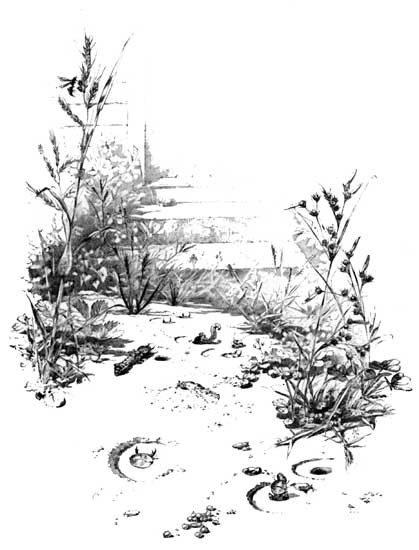
The Door-step Arena, with its Pitfalls
What a danger signal to the creeping insect innocent in its neighborhood! How many a tragedy in the bug world has been enacted in these inviting, clean-swept little door-yards—these pitfalls, so artfully closed in order that their design may be the more surely effective. As I have said, these tunnels are commonly called "ant-holes," perhaps with some show of reason. It is true that ants occasionally are seen to go into them, but not by their own choice, while the most careful observer will wait in vain to see the ant come out again. Here at the edge of the grass we see one approaching now—a big red ant from yonder ant-hill. He creeps this way and that, and anon is seen trespassing in the precincts of the unhealthy court. He crosses its centre, when, click! and in an instant his place knows him no more, and a black hole marks the spot where he met his fate, which is now being duly celebrated in a supplementary fête several inches belowground.
A poor unfortunate green caterpillar, which, with a very little forcible persuasion in the interest of science, was induced to take a short-cut across this nice clean space of earth to the clover beyond, was the next martyr to my passion for original observation. He might have pursued his even course across the arena unharmed, but he too persisted in trespassing, and suddenly was seen to transform from a slow creeping laggard into the liveliest acrobat, as he stood on his head and apparently dived precipitately into the hole which suddenly appeared beneath him. A certain busy fly made itself promiscuous in the neighborhood, more than once to the demoralization of my necessary composure, as it crept persistently upon my nose. What was my delight when I observed the fickle insect in curious contemplation of a pair of calipers at the centre of one of the little courts! But, whether from past experience or innate philosophy in the insect I know not, the pronged hooks, though coming together with a click once or twice at the near proximity of the tempter, failed in their opportunity, and the trap was soon seen carefully set again, flush with the ground at the mouth of the burrow.
The contrast of these clean-swept door-yards with the mound of débris of the ants suggested an investigation of the comparative methods of burrowing and the disposal of the excavated material. Here is a hole evidently some inches in depth; what, then, has become of the earth removed? Suiting action to the thought, I swept into the openings of two or three of the holes quite a quantity of loose earth scraped from the close vicinity, and thus completely obliterated the opening of burrow, door-yard and all.
I awaited in vain any sign of returning activity at the surface, and, my patience being somewhat taxed, I entered my studio, where I remained for a quarter of an hour, perhaps. Upon stealing cautiously to the doorway, I observed all the obliterated holes had reappeared, and upon taking once more my original position I was soon rewarded with a demonstration of the method of excavation. After a moment or two a pellet of earth seemed suddenly to rise from within the cavity, and when arrived at the level of the ground was suddenly shot forth a distance of five or six inches, as though thrown from a tiny round flat shovel, which suddenly flashed from the opening, and as quickly retired to its depths, though not without a momentary display of two curved prongs and a formidable show of spider-like legs.
After a short lapse of time the act was repeated, this time a tiny stone being brought to the surface, and, after a brief pause at the doorway, was jerked to a distance as from a catapult. I now concluded to try the power of this propelling force, and taking a small stone, about three-quarters of an inch in length and a quarter-inch in thickness, laid it over the mouth of the tunnel. A few minutes passed, when I noticed a slight motion in the stone, immediately followed by a forcible ejectment, which threw it nearly an inch, the propelling instrument retiring so quickly into the burrow beneath as to scarce afford a glimpse. The stone appeared almost to have jumped voluntarily.
For an hour or more the bombardment of pellets and small stones continued from the mouth of the pit, until a small pile of the spent ammunition had accumulated at several inches distance, and at length the hole entirely disappeared, the earth in its vicinity presenting an apparently level surface—an armed peace, in truth, with the two touchy curved calipers on duty, as already described.

Fishing for Tigers
Following the hint of past experience, I concluded to explore the depths of one of these tunnels, especially as I desired a specimen of the wily tenant for portraiture; and it is, indeed, an odd fish that one may land on the surface if he be sufficiently alert in his angling. No hook or bait is required in this sort of fishing. Taking a long culm of timothy-grass, I inserted the tip into the burrow. It progressed without impediment two, three, six, eight inches, and when at the depth of about ten inches appeared to touch bottom, which in this kind of angling is the signal for a "strike" and the landing of the game. Instantly withdrawing the grass culm, I found my fish at its tip, from which he quickly dropped to the ground. His singular identity is shown in my illustration—an uncouth nondescript among grubs. His body is whitish and soft, with a huge hump on the lower back armed with two small hooks. His enormous head is now seen to be apparently circular in outline, and we readily see how perfectly it would fill the opening of the burrow like an operculum. But a close examination shows us that this operculum is really composed of two halves, on two separate segments of the body, the segment at the extremity only being the true head, armed with its powerful, sharp, curved jaws. As he lies there sprawling on his six spider-like legs, we may now easily test the skill of his trap, and gain some idea of his voracious personality.
If with the point of our knife-blade, holding it in the direction of the insect's body, we now touch its tail, what a display of vehement acrobatics! Instantly the agile body is bent backward in a loop, while the teeth fasten to the knife-blade with an audible click. If our finger-tip is substituted for the steel, the force of the stroke and the prick and grip of the jaws are unpleasantly perceptible.
In order to fully comprehend the make-up of this curious cave-dweller we must turn biologists for the moment. He must be considered from the evolutionary stand-point, or at least from the stand-point of comparative anatomy.
The first discovery that we make is that as we now see him he is crawling on his back—a fact which seems to have escaped his biographers heretofore. It is, in truth, the underside of his head which is uppermost at the mouth of the burrow, and his six zigzag legs are distorted backward to enable him to keep this contrary position. And what a hideous monster is this, whose flat, metallic, dirt-begrimed face stares skyward from this circular burrow! Well might it strike terror to the heart of the helpless insect which should suddenly find himself confronted by the motionless stare of these four cruel, glistening black eyes! But he is now a "fish out of water," and is about as helpless, nature never having intended him to be seen outside of his burrow—at least, in this present form. There he dwells, setting his circular trap at the mouth of his pitfall, and waiting for the voluntary sacrifice of his insect neighbors to fill his maw.

Tiger-beetle
But this uncouth shape, which so courts obscurity, is not always thus so reasonably retiring. A few glass tumblers inverted above as many of these larger holes during the summer will intercept the winged sprite into which he is shortly to be transfigured—a brilliant metallic-hued beetle, perhaps flashing with bronzy gold or glittering like an emerald—the beautiful cicindela, or tiger-beetle, known to the entomologist as the most agile winged among the coleopterous tribe; known to the populace, perhaps, simply as a bright glittering fly that revels in the hot summer sands of the sea-shore or dusty country road, making its short spans of glittering flight from the very feet of the observer.
If we capture one of them with our butterfly-net he will be found to bear a general resemblance to the portrait here indicated—a slender-legged, proportionably large-headed beetle, with formidable jaws capable of wide extension, and re-enforced by an insatiate carnivorous hunger inherited from his former estate.
It will thus be seen that all the holes which we observe in the ground are not ant-holes; nor, indeed, are they monopolized by the tiger-beetles. There were other tunnels which I saw dug in my square yard of earth on that morning, which, while not of quite such depth, represented equally deep-laid plans.
While observing my cicindelas on that morning, my attention was at length diverted by an old friend of mine, who gave promise of much entertainment—a tiny black wasp, whose restless, rapid, zigzag, apparently aimless wanderings over the ground brought him into continual danger of contact with the snatching jaws of the cave-dwelling tiger, from which, however, he somehow escaped, though I distinctly heard the occasional clicking of the eager jaws.

The Spider Victim
With short abrupt flights or agile runs of a few inches, accompanied by nervous periodic flirts of the folded wings, the insect had covered pretty much of the ground in a short time, until she at length appeared to have discovered the object of her search, as she withdrew from beneath a sorrel leaf a big fat spider several times as large as herself. Its legs were folded beneath its body, and it was perfectly plain that this was not the first time that it had been in the toils of the wasp, which had evidently stung it into submission and stupor some minutes previous. Tugging bravely at her charge, the little black Amazon dragged her burden nimbly over the ground, pulling it after her in entire disregard of obstacles, now this way, now that, with the same exasperating disregard of eternity which she at first displayed, and at length deposited it on the top of a little flat weed, where it was left, while for five minutes more she pursued the same zigzag, apparently senseless meandering over the entire field of earth. Now she seems again to stumble upon her neglected prey, and taking it once more in her formidable jaws, she lugs it again for a long helter-skelter jaunt, this time depositing it in the neighborhood of a hole, which at first sight might have been considered an "ant-hole," from the débris which lay scattered about in its vicinity. After considerable needless delay, she is seen for once motionless, so far as her legs are concerned, but with her head over the tunnel, while, with flipping wings and rapidly waving antennæ, she investigates its depths. Satisfied that all is well, she again reaches her drowsy spider, by a tangled circuit of about a quarter of a mile—wasp measurement—and taking the victim in her teeth for the third time, finally succeeds in reaching the burrow, into which, without a particle of ceremony, she instantly retreats, dragging her helpless burden after her. Both wasp and spider are soon out of sight, and so remain perhaps for a space of two minutes, when the tips of the nervous antennæ appear at the doorway and the wasp emerges. What now follows is most curious and interesting. With an energy and directness in striking contrast to her previous proceedings, she proceeds to fill the cavity, biting the earth with her mandibles, and with her spiked legs kicking and shoving in the loose soil thus collected, ever and anon backing up to the hole and inserting the tip of her tail to force down the mass. As the filling is nearly completed, with the fore feet and jaws the surrounding earth is scraped for material, which she immediately proceeds to pack by a rhythmic tamping motion of the tail, until, at the end of five minutes, perhaps, the ground-level is finally reached, the surface smoothed, and no sign remains to mark the grave of the stupefied spider victim.



